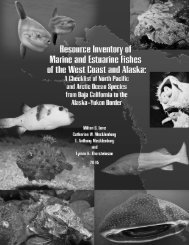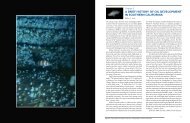Reproductive Ecology and Body Burden of Resident ... - The Love Lab
Reproductive Ecology and Body Burden of Resident ... - The Love Lab
Reproductive Ecology and Body Burden of Resident ... - The Love Lab
Create successful ePaper yourself
Turn your PDF publications into a flip-book with our unique Google optimized e-Paper software.
<strong>The</strong> objective <strong>of</strong> this investigation was to compare the spawning capability, as measured by pronounced<br />
atresia, <strong>of</strong> Pacific s<strong>and</strong>dab (Citharichthys sordidus) living around two oil platforms with fish inhabiting<br />
two natural areas. This species occurs from the western Gulf <strong>of</strong> Alaska to Bahia Magdalena, southern<br />
Baja California, <strong>and</strong> as an isolated population in the Gulf <strong>of</strong> California (<strong>Love</strong> et al. 2005). Pacific s<strong>and</strong>dab<br />
are very widespread throughout southern California waters <strong>and</strong> live both on s<strong>of</strong>t sea floors at natural sites<br />
<strong>and</strong> around oil <strong>and</strong> gas platforms (<strong>Love</strong> et al. 1999; Allen et al. 2007). This flatfish spends much <strong>of</strong> its time<br />
lying on or partially covered in sediment, although we have also seen them well up in the water column. It is<br />
an opportunistic feeder, preying on such benthic infauna as polychaetes, as well as such benthic, epibenthic,<br />
<strong>and</strong> water column organisms including shrimps, gammarid amphipods, mysids, euphausiids, squids, <strong>and</strong><br />
fishes (Allen 1982; Allen et al. 2002). Pacific s<strong>and</strong>dab spawn from late spring through late fall, probably peaking<br />
in the summer (Arora 1951; M. McCrea, pers. comm.). Regional surveys <strong>of</strong> chlorinated hydrocarbon<br />
contamination in the Southern California Bight imply that these fish do not make large-scale movements<br />
(Schiff <strong>and</strong> Allen 2000).<br />
Based on its life history, it would be expected that the Pacific s<strong>and</strong>dab is an excellent species on<br />
which to model the reproductive effects <strong>of</strong> platform discharges. This fish is likely to come into contact with<br />
benthic pollutants, both through direct physical contact <strong>and</strong> absorption, <strong>and</strong> from its diet <strong>of</strong> both sea-floor<br />
infauna <strong>and</strong> epibenthic organisms. And, in fact, Pacific s<strong>and</strong>dab have been shown to bioaccumulate pollutants<br />
<strong>and</strong> have been used as a tool in assessments <strong>of</strong> tissue contamination (Schiff <strong>and</strong> Allen 2000; Allen et al.<br />
2002). <strong>The</strong> lack <strong>of</strong> any evidence <strong>of</strong> substantial reproductive impairment in fish living around two oil <strong>and</strong> gas<br />
platforms implies that large-scale reproductive damage is unlikely to be occurring.<br />
Methods<br />
Pacific s<strong>and</strong>dab were collected at four sites in the Santa Barbara Channel, southern California, by<br />
hook <strong>and</strong> line in September 2005 (Figure 1, Table 1). <strong>The</strong> sampling sites were 1) Platform B, 2) Platform<br />
Gilda 3) a natural site located about 8 km <strong>of</strong>fshore <strong>and</strong> southeast <strong>of</strong> Platform B (“Rincon”), <strong>and</strong> 4) a natural<br />
site <strong>of</strong>f the northeast corner <strong>of</strong> Santa Cruz Isl<strong>and</strong> (“Santa Cruz Isl<strong>and</strong>”). Both platforms have produced oil<br />
<strong>and</strong> gas for many years, Platform B starting in 1968 <strong>and</strong> Platform Gilda in 1981 (<strong>Love</strong> et al. 2003). Platform<br />
fish were collected within 30-60 m <strong>of</strong> each structure.<br />
After capture, fish were placed on ice <strong>and</strong> several hours later were measured (total length, cm), the<br />
ovaries fixed in 10% formalin, <strong>and</strong> later shipped to SRG. A section <strong>of</strong> each ovary was removed, dehydrated<br />
in ethanol <strong>of</strong> ascending concentrations, embedded in paraffin <strong>and</strong> serial sections were cut at 5µm using a<br />
rotary microtome. Sections were mounted on glass slides, stained with hematoxylin followed by eosin counterstain.<br />
Slides from each ovary were examined under a compound microscope. <strong>The</strong> presence <strong>of</strong> the following<br />
was noted: (1) hydrated eggs for upcoming spawning; (2) vitellogenesis (yolk deposition) in mode <strong>of</strong><br />
smaller eggs for subsequent spawning; (3) postovulatory follicles (evidence <strong>of</strong> recent spawning); (4) follicular<br />
atresia (degenerating oocytes). Atresia was characterized as minor (




